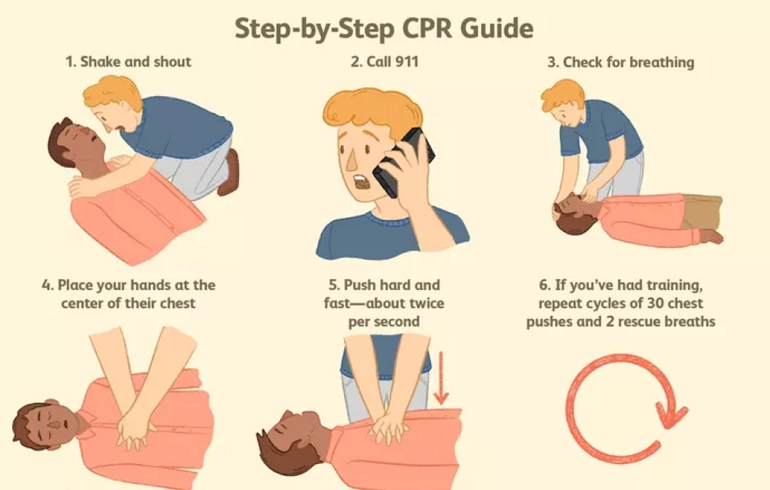If you have private health cover with Allianz, BUPA Australia, Medibank, or NIB, Please talk to our staff to check your eligibility.
Click here for private health insuranceHow To Perform CPR - Read It Because You Could Save A Life

Witnessing someone go into cardiac arrest is terrifying, but If you know how to perform CPR, you could save the patient's life. Officially known as Cardio-Pulmonary Resuscitation (CPR), CPR involves helping the patient's heart to continue pushing oxygen around the body until they can reach expert medical attention. Understanding how to perform CPR, could make all the difference in those crucial seconds and minutes.

Start With the ABCD Approach
Let's say you see someone collapse in front of you. How do you know whether to start CPR or not? It all begins with a primary survey. A primary survey involves assessing a trauma/emergency patient to determine the best way to care for them. In most settings, you can use the ABCDE approach:
Airway
Begin by shaking the patient firmly by the shoulders and saying loudly and clearly "Are you okay?". If they don't respond, place one hand on their forehead and another beneath their jaw. Tilt their head backwards and lift the chin so you can move onto assessing their breathing.
Repeat the shaking and clear speaking. If the patient still doesn't respond, they may be unconscious rather than in cardiac arrest. To get a clearer idea of what's happening, you need to assess their breathing.
Breathing
Assess the patient's breathing by holding your ear close to their nose and mouth. Listen for 10 seconds. If you don't hear continuous breathing, this may be a sign that the person is in cardiac arrest. Naturally, you may not always hear breathing, but there are other ways to make sure it's happening. Try to feel the person breathing onto your cheek with your face a few centimeters from their mouth. Count to ten and watch for their chest rising and falling. Again, an absence of these signs indicates that the patient is in cardiac arrest.
It's important to note that some patients may make a random gasping sound. This sound is known as an agonal gasp and isn't true breathing. As such, you should move onto the next stage of CPR.
Call for Help
When you're sure someone is in cardiac arrest, call for help before beginning chest compressions. This could mean getting the attention of someone else nearby or calling for an ambulance.Chest Compressions
Once you've called for help, you should begin chest compressions without hesitation. Place one hand over the other over the person's breastbone. Keep the bottom hand flat and interlock the fingers from both hands.
Begin compressing the person's chest, pressing in 5cm with each compression. Aim for two chest pumps per second. Do this 30 times, then use the same head lifting manoeuvre detailed above (A for Airway section).
Open the patient's mouth slightly, form a seal over their mouth with yours, and breathe into it sharply. Do this twice. If you're unsure as to whether your rescue breaths were effective, don't waste time trying to get it right. Instead, immediately perform another 30 compressions and then another two rescue breaths.
Some people don't feel comfortable with delivering effective rescue breaths. Evidence shows that performing compressions without rescue breaths improves your chances of success if you're unsure of how to rescue breaths work.
Defibrillator
If you're performing CPR as a layman, the defibrillator element of CPR is optional. However, if someone in the area has the right training and can access a defibrillator, allow them to use it. Individuals who've been trained in defibrillator use will be able to guide you on the moves you need to make next.
CPR for Adults Vs CPR for Kids
CPR for adults is often different from CPR for kids unless the child is particularly large and around the size of an adult.
One of the biggest differences with CPR for kids is how you perform chest compressions. If the child is small, you can use one hand for compressions. As with CPR for adults, aim for 5 cm of compression.
If you're performing CPR on a baby, use two fingers from your dominant hand to perform compressions. Aim for around 3 cm of compression.
Many medical professionals recommend moving through two minutes of compressions and rescue breaths when performing CPR for kids. This is because the cause of an arrest in a child is often respiratory.
Tips for Success
If you've never performed CPR for adults or kids before, it's worth understanding that full recoveries aren't the norm. Only around 12% of out-of-hospital CPR attempts are successful. Although that may seem disheartening, by performing bystander CPR you are in fact doubling the patient's chances of survival.
There are ways you can make your CPR efforts more effective and easier. Take a look at our tips for success.
Rotate Compressions
After two minutes, your strength may reduce and your ability to perform effective compressions may begin to dwindle. If possible, ask another person if they can take over compressions for you at this time. Better still, try rotating compressions between three of you.
Use a Rhyme or Song
Try repeating a rhyme or verse in your head to give you good rhythm. Some global charities recommend using the chorus rhythm from the song Staying Alive by The Bee Gees to time your compressions.
Stay Safe
Only perform CPR when you believe it's safe to do so. There are some situations that could place you in danger, rendering your efforts useless. In some scenarios, you may need to move the patient to a safer location before starting the process. However, you should only do this if you're confident there are no spinal injuries and that it is safe to move the patient.
Call 000
Always call 000 before starting CPR for adults, or after two minutes of CPR for kids. The call handlers you speak to will be able to offer guidance in any situation you're unsure of. They will also help count the compressions with you, which is useful when you're feeling nervous.
Knowing how to perform CPR could save someone's life. Having such skills as a bystander can make a significant difference in the case of a cardiac arrest. At 13 Cure, we're here for all your home doctor needs. Contact us if you need to speak to a doctor for everyday medical care, but always call 000 if you suspect you're dealing with an emergency.

Name: Dr. Muhammad Mohsin, General Practitioner
University Degree: MBBS, AMC
Bio: Dr. Muhammad Mohsin completed his studies from Univerisity of Health Sciences, Lahore Pakistan in 2008. He came to Australia in 2012 and has worked as a resident and GP in various hospitals and medical centres across Australia. He has a particular interest in men's health, travels medicine, chronic disease management, and general family medicine.


